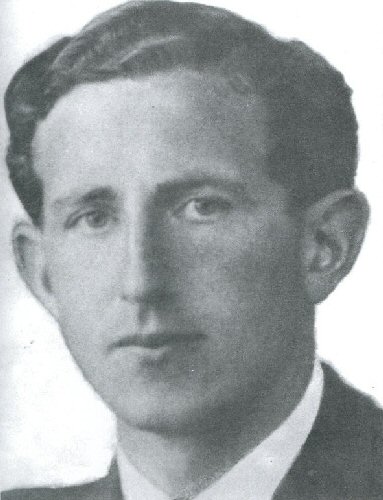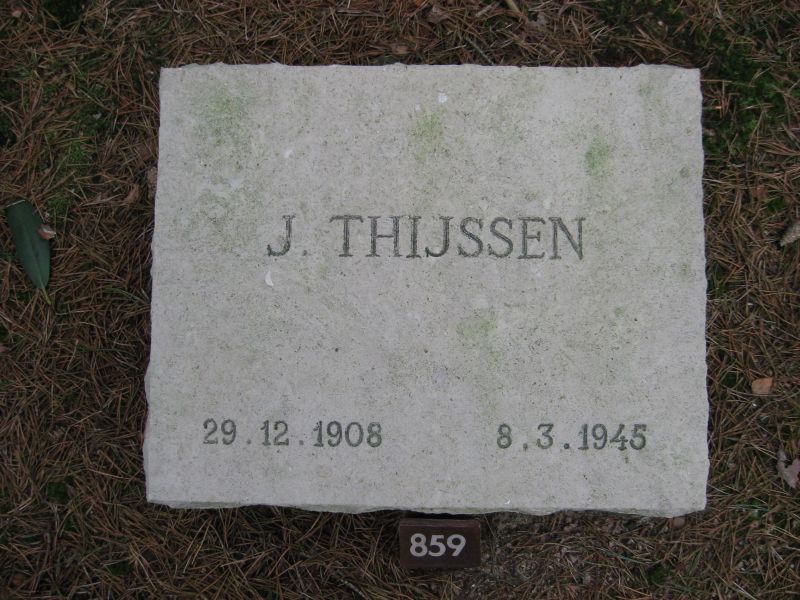Thijssen, Jan
- Date of birth:
- December 29th, 1908 (Bussum, The Netherlands)
- Date of death:
- March 8th, 1945 (Woeste Hoeve-Apeldoorn, The Netherlands)
- Buried on:
- Dutch Field of Honour Loenen
Plot: A. Grave: 859. - Nationality:
- Dutch
Biography
Before the war, Jan Thijssen was employed by the PTT (Dutch National Telephone Service) as an electrical engineer, tracking down illegal transmitters. After the Germans had invaded the country, he soon got the idea of establishing a nationwide radio network in support of the underground. In 1942 he contacted the Ordedienst (O.D.), one of the premier nationwide underground organizations which was led by career officers and was military in nature. He presented his plan to the O.D. Chief of Staff, Jhr. P.J. Six who accepted his idea. Thanks to Thijssen's committment, a nationwide communication network was all but completed in 1942. In this he was heavily supported by a chemist, J. Hoekstra, employed by N.V. Philips in Eindhoven and who succeeded in -illegally- acquiring from the factory various parts vital to the radio network with the help of a family member.
Thijssen grew disillusioned when it became clear to him that the O.D. wished to use his radionetwork solely for their own purposes. He also felt irritated by the much too passive attitude of the O.D.. He advocated a new, nationwide organization, which was to fully occupy itself with active resistance like sabotage and keep in close contact with the Allies. At the end of April 1943, along with six other underground workers, including the Communist D. van der Meer from Amersfoort. he established the R.V.V. (Raad van Verzet, the Council for Resistance in the Kingdom of the Netherlands). Van der Meer resigned a month later and was succeeded by G. Wagenaar, one of the national leaders of the Military Commission, the resistance movement of the Dutch Communist Party.
The April/May general strike of 1943, started spontaneously following a notification by German General Christiansen to the effect that all former Dutch military personnel be returned to imprisonment as POW's, caused Thijssen to call for a boycott of this measure and to committ sabotage. He was the first to inform London of this strike and his proposed actions through his own transmitter.
During 1943 and 1944, the R.V.V. performed liquidations, raided distribution offices and public records and committed acts of sabotage. However, the objective of the R.V.V. to gain overall leadership within the active resistance was not reached. This was partly due to the fact that the illegally printed organ of the C.P.N. 'De Waarheid' (Truth) identified itself more and more with the R.V.V., lending the organization an -albeit undeserved- communist aura. The O.D. and the R.V.V. couldn't agree on matters either causing the Chief Staff of the O.D., Jhr. P. Six to oust Jan Thijssen as Chief of Radio Service of the O.D. There was also much rivalry between the R.V.V. and the Landelijke Knokploegen (L.K.P., National Raiding Parties).
From April 1944 onwards, the R.V.V. maintained radio contact with the London based Bureau of Intelligence, established with the assistance of Thijssen's friend and colleague A.W.M. Ausems who had been trained in England as a secret agent. July 1944, at Deurne Castle, a meeting took place between the national leaders of the R.V.V. At this meeting, Thijssen proposed the establishment of an Operations Center, to be headed by himself. The existing R.V.V. groups had to be transformed into small sabotage groups to be deployed mainly against the German Army.
In part aided by local resistance activities, the Allied drive through western Europe progressed faster than had been anticipated. At the end of August, the L.K.P. and the R.V.V. also received weapons by airdrops and the Allied Supreme Command gave orders for large-scale sabotage acts directed against the Dutch railway system. There was however a split between Jan Thijssen's R.V.V. and Frank van Bijnen's L.K.P.; the latter having been named National Commander of Sabotage within the L.K.P. on August 25th, 1944. Problems were inevitable and so, on September 12th, the newly appointed commander of the Binnenlandse Strijdkrachten (B.S., Internal Armed Forces), H.R.H. Prince Bernhard ordered the L.K.P., the R.V.V. and the O.D. to start the so-called Delta council to end the rivalry between the various organizations. Colonel Henri Koot was asked and he accepted to take command of the B.S. He requested to be permitted to set up his HQ in Amsterdam. At that time however, Jan Thijssen and Frank van Bijnen were heavily involved in underground activities in support of the battle for Arnhem which was in progress at that very moment. Therefore they were absent from the Delta meeting in Amsterdam. As a result, the O.D. claimed ever more power for itself, something Thijssen could only disagree with. Among other things, he claimed the weapons that had been dropped for himself. He also clashed with Van Bijnen and a crisis within the B.S. was looming. The disagreement went on for weeks and erupted when 'Commander Delta' Koot relieved Thijssen of his function. A few days later, November 8th, on the highway between Rotterdam and The Hague driving a Red Cross van, Thijssen was arrested by the Germans Thijssen was taken to a prison in Zwolle. March 8th, Jan Thijssen was executed. He was one of 116 inmates from various prisons, mainly members of the resistance, who were taken to De Woeste Hoeve and shot in reprisal of the raid on SS-Obergruppenfuhrer und General der Waffen-SS und der Polizei, (General of the SS, Waffen-SS and Police) Hans Rauter. The prisoners, in five groups of twenty and one of sixteen, were taken to the exact location of the raid near De Woeste Hoeve and shot. The German Oberwachtmeister der Ordnungspolizei (Chief of Police), Helmut Seijffards who refused to be a member of the firing squad, was executed on the spot as well. Of all the people being led to their execution, Jan Thijssen was the only one attempting to escape, a remarkable example of rebelliousness and resistance to the bitter end. In his prison cell in Zwolle, he wrote a few phrases on the wall: "Ons slaat geen stormwind neder", "Het hart kent zijn eigen droefheid alleen" en "Spijt, smart en schrik door dun en dik. De dood steeds in ’t zicht na vreselijk gericht. Gestreden onversaagd tot de vrijheidzonne daagt!". ( "No storm will bring us down", "Only the heart knows its own sadness", and "Regret, grief and fright against all odds. Always facing death after terrible Judgment. In struggle undaunted 'till the sun of freedom rises").
Do you have more information about this person? Inform us!
- Period:
- Second World War (1939-1945)
- Rank:
- Res. 1e luitenant der artillerie (1st Lieutenant of Reserves)
- Unit:
- Raad van Verzet in het Koninkrijk der Nederlanden” (R.V.V.), Nederlands Verzet
- Awarded on:
- December 14th, 1949
Posthumous award.
Royal Decree No. 24, December 14th, 1949.
- Period:
- Second World War (1939-1945)
- Unit:
- Raad van Verzet in het Koninkrijk der Nederlanden” (R.V.V.), Nederlands Verzet
- Awarded on:
- April 8th, 1953
Medal presented in The Hague, 8 April, 1953 to the widow of Gerrit Pruys.
Sources
- Photo 1: STIWOT
- Photo 2: André Reijniers
- - MEIJER, H.G., Bronzen Leeuw, Bronzen Kruis, De Bataafsche Leeuw, Amsterdam, 1990.
- De Papieren Oorlog, EO Tweede Wereldoorlog documentaire, VTCMEDIA, 2005
- onderscheidingen.nl
- Website Gemeente Rijswijk
- telecompas.nl
- Dissertations of the University of Groningen
- Slachtoffer Register Oorlogsgravenstichting
- Overlijdensakte 888 d.d. 31 mei 1945 gemeente Apeldoorn






